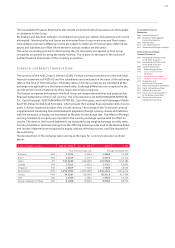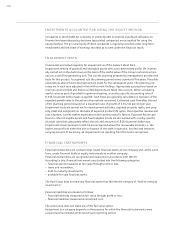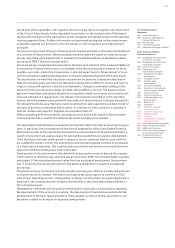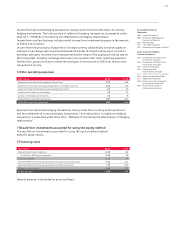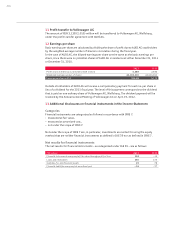Audi 2011 Annual Report Download - page 211
Download and view the complete annual report
Please find page 211 of the 2011 Audi annual report below. You can navigate through the pages in the report by either clicking on the pages listed below, or by using the keyword search tool below to find specific information within the annual report.
208
Fluctuations in value are accounted for within equity in the reserve for the market valuation of
securities, after taking deferred tax into account. Unless there is evidence of lasting impairment,
the financial result includes only capital gains or losses realized through disposal.
“Available-for-sale financial assets” are impaired if there is objective evidence of a long-term loss
of value. In the case of equity instruments, a long-term loss of value is deemed to have occurred
if the market value falls below the cost of purchase on a significant basis (more than 20 percent)
or on a long-term basis (more than 10 percent of the average market prices throughout a year).
Debt instruments are impaired if future payment flows from the financial asset are expected to
fall. Any rise in risk-free interest rates or credit spreads, however, does not constitute objective
evidence of a loss in value.
As soon as impairment occurs, the cumulative loss is removed from the reserve for the market
valuation of securities and recognized in the Income Statement. Reversals of impairments –
provided that the securities affected are equity instruments – are recognized without affecting
income. If, on the other hand, the securities concerned are debt instruments, impairment losses
are reversed with an effect on income if the increase in the fair value, when viewed objectively, is
based on an event that occurred after the impairment loss was recorded with an effect on income.
As well as securities, the item “Available-for-sale financial assets” also contains other long-term
investments that are not valued according to the equity method. As there is no active market for
the other financial assets, they are carried at amortized cost. Where there is evidence that the
fair value is lower, corresponding value adjustments are carried out.
Derivative financial instruments and hedge accounting
Derivative financial instruments are used as a hedge against foreign exchange and commodity
price risks for items on the Balance Sheet and for future cash flows (underlying transactions).
Futures, as well as options in the case of foreign exchange risks, are used for this purpose.
Additionally, under the rules of IAS 39, some contracts are classed as derivative financial
instruments:
– Rights to acquire shares in companies
– Agreements entered into by the Audi Group with approved dealers with a view to hedging
against potential losses from buy-back obligations for leased vehicles.
A requirement of hedge accounting is that a clear hedging relationship between the underlying
transaction and the hedge must be documented and its effectiveness demonstrated.
Recognition of the fair value changes in hedges depends on the nature of the hedging relationship.
When hedging against exchange rate risks from future cash flows (cash flow hedges), the fluc-
tuations in the market value of the effective portion of a derivative financial instrument are
initially reported within equity in the reserve for cash flow hedges, with no effect on income, and
are only recognized as income or expense once the hedged item is due. The ineffective portion of
a hedge is recognized immediately in income.
Derivative financial instruments that are used to hedge market risks according to commercial
criteria but that do not fully meet the requirements of IAS 39 with regard to effectiveness of
hedging relationships are classified as “measured at fair value through profit or loss.”
Rights to acquire shares in companies, and the model for dealer hedging against potential losses
from buy-back obligations for leased vehicles, are also reported in accordance with the rules for
“financial instruments measured at fair value through profit or loss.”







